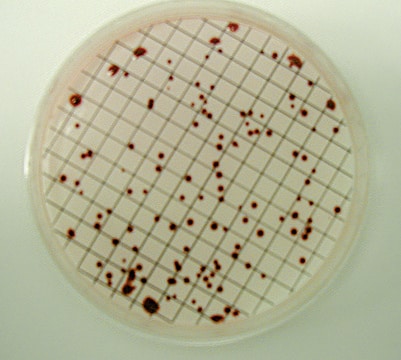17779
2,3,5-Triphenyl-tetrazolium chloride solution
suitable for microbiology, Filter sterilized solution that is recommended for the detection of microbial growth based on reduction of TTC
Synonim(y):
TTC solution, TTC supplement, TTC solution, TTC supplement
About This Item
Polecane produkty
Poziom jakości
sterylność
sterile (Filtered and Aseptic Handled)
Postać
liquid
okres trwałości
limited shelf life, expiry date on the label
masa cząsteczkowa
334.8 g/mol
Zastosowanie
agriculture
environmental
food and beverages
microbiology
temp. przechowywania
2-8°C
przydatność
bacteria
ciąg SMILES
[Cl-].c1ccc(cc1)-c2nn(-c3ccccc3)[n+](n2)-c4ccccc4
InChI
1S/C19H15N4.ClH/c1-4-10-16(11-5-1)19-20-22(17-12-6-2-7-13-17)23(21-19)18-14-8-3-9-15-18;/h1-15H;1H/q+1;/p-1
Klucz InChI
PKDBCJSWQUOKDO-UHFFFAOYSA-M
Opis ogólny
Zastosowanie
Komponenty
2,3,5-Triphenyl tetrazolium chloride: 0.1 g, distilled water: 10 ml
Kod klasy składowania
10 - Combustible liquids
Klasa zagrożenia wodnego (WGK)
WGK 2
Temperatura zapłonu (°F)
Not applicable
Temperatura zapłonu (°C)
Not applicable
Środki ochrony indywidualnej
Eyeshields, Gloves
Choose from one of the most recent versions:
Masz już ten produkt?
Dokumenty związane z niedawno zakupionymi produktami zostały zamieszczone w Bibliotece dokumentów.
Klienci oglądali również te produkty
Produkty
Vibrios are motile, curved or comma-shaped bacilli and have a single polar flagella with sheet proteins. They are often found in open water, freshwater and saltwater.
Większość wibrysów wykorzystuje proste źródło C, takie jak glukoza, jako źródło energii i wymaga 2-4% NaCl lub innych soli i pierwiastków śladowych obecnych w wodzie morskiej dla optymalnego wzrostu. Niektóre gatunki mogą wykorzystywać różne źródła energii.
Nasz zespół naukowców ma doświadczenie we wszystkich obszarach badań, w tym w naukach przyrodniczych, materiałoznawstwie, syntezie chemicznej, chromatografii, analityce i wielu innych dziedzinach.
Skontaktuj się z zespołem ds. pomocy technicznej







